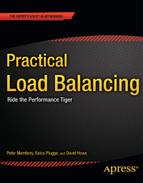Preface
Load balancing, caching, and performance remain in very high demand, but the perception that they are either extremely expensive, difficult, or both has managed to persist. It is perhaps not all that surprising, as not so long ago only a few large or specialist companies really needed to take such things seriously. Today, though, even a personal blog can get so much traffic that the server can’t cope, and company web sites simply have to be up and running all day, every day—no matter what. If you have a site that has to be fast and reliable all the time but you’re not sure where to start or you don’t have a multimillion-dollar budget (or even if you do!), this book can help!
Target Audience
This book is for anyone who has ever built a web site and wondered how to make it scale to many thousands of users. The holy grail of performance and reliability need not be restricted to large companies with huge budgets; anyone can use this book to give their applications a severe kick in the pants!
It is also for people who are hoping to build the next great thing and want to be sure that whatever they build can cope with the eventual strain of countless users.
Book Structure
This book is divided into the traditional three parts. First, we start off by introducing the key ideas behind load balancing and caching—and why you should pay attention to them. In part one, we cover the basics. We take a look at the mechanics of a web site: we take each of the pieces apart one by one so you can see how they interact and the importance of their place in the puzzle. Next up is a bumper chapter on caching. We look at its past, the huge variety of caching techniques, and how to get started with a couple of the core technologies. We then look at how DNS can be used as a simple load balancing system, followed by a hands-on tutorial on getting up and running with a content delivery network (as well as what one of those is and why you want one). We round off part one with a look at project management and backups, and how you can often plan your way into excellent performance.
Part two is where you start to get your hands really dirty. You learn the essential concepts you need to attempt the challenges in Chapter 7. In Chapter 8, we show you how to load balance your web servers. Chapter 9 follows in the same vein by giving your database the load balancing treatment. Chapter 10 demonstrates how to load balance the network itself, and Chapter 11 covers how to load balance your SSL connections.
In part three, we go beyond the usual suspects. Chapter 12 shows how to set up your systems for high availability. Chapter 13 discusses the cloud and the way it will change the game as far as performance is concerned. Chapter 14 looks at IPv6 and how you can apply the techniques you’ve learned to this platform. Finally, in Chapter 15 we review what you’ve learned so far and cover some related topics such as security, planning, and improving performance in the operating system.
Downloading the Code
A source code link is available on the book’s page at www.apress.com in the Source Code/Downloads tab. This tab is located underneath the Related Titles section of the page. To locate your book's information page, enter the title or the 13-digit ISBN in the Search bar.
